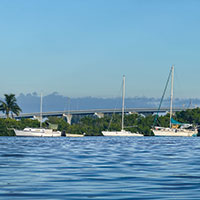 County hopes new anchoring rules stem tide of derelict boats here
County hopes new anchoring rules stem tide of derelict boats here
STORY BY JON PINE (Week of September 11, 2025)
The county commission has approved a new ordinance that aims to reduce the number of boats abandoned in local waters by designating areas where boaters may not anchor their vessels for more than 45 days in any six-month period.
Anyone who regularly drives over the bridges connecting the barrier island with the mainland has seen half-submerged sailboats or derelict cruisers languishing in the lagoon for months while officials try to find the owners and get the boats hauled away.
“Derelict vessels cause damage to our waterways,” said Melissa Meisenburg, a senior lagoon environmental specialist with the county. Besides being eyesores and navigational hazards, abandoned vessels can leak engine oil, gas and other pollutants into the water, and sunken hulls can damage fragile seagrass and oyster beds.
Last year, the county had to remove 13 derelict vessels from the lagoon, with two more hauled away so far this year, at a total cost of $121,100, according to Meisenburg.
To mitigate the problem, county commissioners on Aug. 19 approved an ordinance that establishes six Anchoring Limitation Areas (ALA) totaling 176.7 acres in the Indian River Lagoon within the boundaries of the City of Vero Beach, and three ALAs totaling 209.6 acres within the Town of Indian River Shores.
The Vero anchoring limitation areas are mostly near but not within the boundaries of the city marina, where many boat owners anchor so that they can go ashore in dinghies to use facilities or catch the GoLine bus that stops there.
The restricted areas include small inlets and passages north of the marina and a large swath of water south of the Merrill Barber Bridge that encompasses Farley Island and the inlet between Quail Valley River Club and the Riomar Bay subdivision.
Another 42-acre restricted area lies just south of the Alma Lee Loy Bridge, in waters often used by Youth Sailing Foundation instructors and students.
Restricted areas in Indian River Shores include 97 acres north of the Vero Beach Marina, including McCullers Cove, and parts of the John’s Island shoreline.
Florida law regulates the anchoring of vessels, but counties must designate anchoring limitation areas to enforce the regulations. Only a percentage of a municipality’s waters can be restricted, so Vero Beach and The Shores picked areas where boats tend to be anchored for prolonged periods and sometimes abandoned.
Prior to the new regulations, a person could legally anchor an unused and unseaworthy vessel for months or years at time in public waters while it deteriorated.
Under the new ordinance, vessels may not be anchored within an ALA for more than 45 consecutive days in any six-month period. Once that time limit is reached, the vessel must be moved at least one mile away. Violators may be issued citations. If cited vessels are not moved, they may be impounded. If a vessel receives three violations in one year, it would be declared derelict and removed.
“This ordinance may not stop people from abandoning vessels in these areas, but we are hopeful it will speed up the removal process,” Meisenburg told Vero Beach 32963. Instead of waiting for a boat to sink to identify it as derelict, law enforcement officers will be able to determine that it’s abandoned or unseaworthy and facilitate removal while it is still afloat.
In an email to Vero residents, City Councilmember Aaron Vos wrote that, “according to Vero Beach Police Chief David Currey, if this ordinance had already been in effect, 15 of 19 vessels currently anchored in the [newly designated areas] would be in violation.”
The nine anchoring limitation areas will be identified by buoys and signs. An engineering firm will work with The Florida Fish and Wildlife Conservation Commission to determine how many markers will be needed and where they should be installed, Meisenburg said.
The cost to create the restricted areas is estimated to be $329,000, but that amount could change once the exact number of buoys and signs is determined by FWC, Meisenburg said. The engineering consultant will handle the permitting required by FWC and the U.S. Army Corps of Engineers and will create a bid package for contractors. They will also oversee construction, she said.
Depending on the permitting process and the weather, the new anchoring limitation areas should be marked and operational within a year or so, Meisenburg said.



